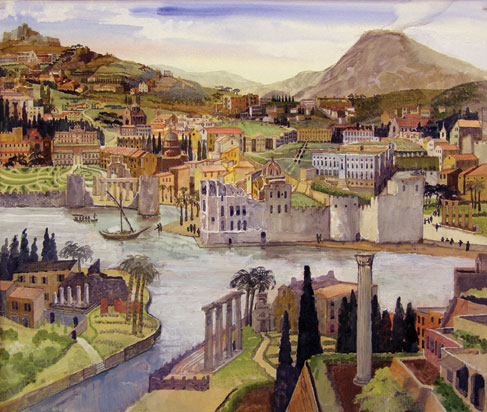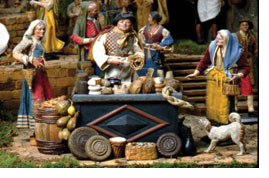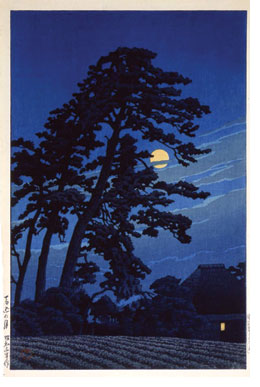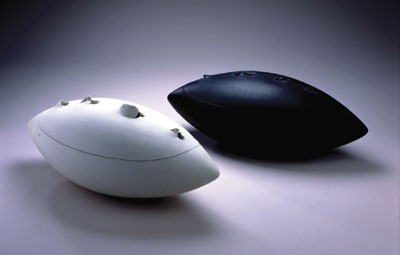
Presepio Gets Neapolitan
Backdrop
Thanks to Women’s Committee
The Women’s Committee has commissioned Pittsburgh
artist Robert Bowden to create a mural to serve as
a backdrop for the beloved Presepio, the 18th-century
Neapolitan Nativity scene that is displayed every year
in the Hall of Architecture throughout the holidays.
Elisabeth Agro, assistant curator of Decorative Arts,
says the Presepio came with a backdrop when it was
purchased from a collector in 1956, but that the backdrop
was not in the Neapolitan style and hasn’t been
used in many years.
 “
The new mural is wedded to what is in the Presepio architecturally and structurally,” says Agro.
She explains that Bowden is painting it in the style
of an 18th-century Neapolitan landscape, and is including
the Bay of Naples, ships, Mt. Vesuvius, palazzi and
other buildings, ancient ruins, formal gardens, and
more. “
The new mural is wedded to what is in the Presepio architecturally and structurally,” says Agro.
She explains that Bowden is painting it in the style
of an 18th-century Neapolitan landscape, and is including
the Bay of Naples, ships, Mt. Vesuvius, palazzi and
other buildings, ancient ruins, formal gardens, and
more.
Bowden is painting the landscape in oil on
a 60-inch x 52-inch canvas, which will then be
enlarged to
a huge backdrop of more than 17-feet wide by 15-feet
high to suit the Presepio’s 21-foot-wide
platform. Visitors also will have the opportunity
to see Bowden’s
original watercolor sketch and oil canvas beside
the mural to gain an understanding of the artistic
process.
The Presepio features buildings and more
than 100 human figures with terra cotta heads
and dressed in original fabric clothing. The figures
include
members of the Nativity as well as Neapolitan
aristocrats, officials, and peasants. The Presepio has been a Carnegie Museums’ tradition since
its purchase in 1956.
Holiday Trees Bring Fantasy to Life
Continuing a long-standing holiday tradition at
Carnegie Museum of Art, the Women’s Committee
has envisioned four more fanciful ways to decorate
the 20-foot trees that will stand in the Hall
of Architecture Thursday, December 2 through
Sunday, January 9. Working within the theme of “Children’s
Fantasies of Christmas,” committee members
are creating beautiful ornaments and objects
that will deck the trees. With your museum admission,
you’ll have the opportunity to delight
in the four trees: “Space Child’s
Christmas,” depicting Santa’s gift
delivery to children on other planets; the “Unicorn” tree,
featuring the Unicorn of Flemish tapestries fame; “Night
Before Christmas,” capturing Santa’s
visit as described in the Clement Moore poem;
and the “Fairy” tree, featuring gossamer
fairies from myths and literature, along with
their forest and toadstool homes.
Holiday Tree Preview Party
Wednesday, December 1, 2004
6-8:30 p.m.
Hall of Architecture
$40 per person
Cocktails and hors d’oeuvres; for reservations
call 412-622-3325.
Holiday Party for Special Guests
Close to 200 special guests—children and
adults alike—are expected to enjoy a delightful
afternoon of food and festivities at this year’s
Holiday Party for Special Guests, sponsored by
the Women’s Committee of the Museum of Art.
The guests are students from the Day School at
The Children’s Institute, Mon-Yough TAC/W,
Western Pennsylvania School for Blind Children,
Easter Seals School East, Western Pennsylvania
School for the Deaf, Allegheny Valley School, and
The Pace School. They will be treated to lunch,
gifts of beanie baby animals, a visit from Santa,
and lots of music-making—ranging from the
jingling bells they’ll wear on ribbons, to
a sing-along and holiday favorites played by the
Mt. Lebanon High School Orchestra.
Volunteer Betsy
Kampmeinert is arranging the holiday party this
year. “Singing together is great
fun for the guests and is a bonding experience
for the volunteers,” she says. “This
party is always a
terrific time!”
 Upcoming Exhibition Upcoming Exhibition
Kawase Hasui: Landscapes of Modern Japan
November 13, 2004–February 27, 2005
Works on Paper Gallery
For centuries, Japan was known for its woodblock
print tradition. In the early 20th century, Japanese
print designer Kawase Hasui (1883–1957) was
active in the shin hanga or new print movement
intended to revive the flagging tradition. Hasui
worked closely with publisher Watanabe Shozauro,
and become one of the publisher’s most successful
artists. Hasui is noted for capturing the effects
of weather and light on the landscape, and traveled
the country in search of suitable subjects.
The
exhibition will include approximately 70 prints
and watercolors from the James B. Austin Collection
at Carnegie Museum of Art, along with several
works from a private Pittsburgh collection. Kawase
Hasui, Japanese, 1883-1957, Moon Over Magome (Magome no tsuki), 1930. Woodcut on paper. Carnegie
Museum of Art. Bequest of Dr. James B. Austin.
Recent Acquisition:
Concetto
Spaziale Black, 1968, and Concetto Spaziale White,
1968, by
Lucio Fontana 
Lucio Fontana, designer, Rosenthal Porcelain
Factory, manufacturer, Concetto Spaziale -
White, 1968, and Concetto Spaziale - Black,
1968, Ailsa Mellon Bruce Fund, 2004.20.1 and
2004.20.2
Born in Argentina and raised in Milan, Lucio
Fontana (1899-1968) is revered as one of the
major forces
in 20th-century art. A painter, sculptor, and
theorist, Fontana was an avant-gardist interested
in exploring
three-dimensional space, especially in his ceramics
works. According to noted ceramics historian,
Garth Clark, “Fontana was not just a
ceramist, but could well be the most important
artist to
work in this medium in the 20th century.”
The
Concetto Spaziale White and Concetto
Spaziale Black are among Fontana’s final work
in ceramics and were produced as a series in
porcelain
by Rosenthal.
What is unusual about this series is that they
combine mechanical and manual production. Rosenthal
made the bodies from a mold, and Fontana then
added the punctured holes and oval gashes by
hand, making
each object in the series different.
Curator
of Decorative Arts Sarah Nichols says, “The
pieces were conceived to stand alone or to
be paired and, I think, by pairing, the sum
is greater than
the individual parts. It speaks to another
important aspect of Fontana’s work—opposites
creating a whole or the two sides of the coin
of life.” Nichols adds, “The pair
might stand for light and dark, day and night,
male and
female, or the hand and the machine.” The
Museum of Art previously acquired Fontana’s
1962 copper sculpture, Concetto Spaziale (Attesa).
Nichols
says, “These ceramic works are an
important acquisition for this museum because
they represent a critical aspect of Fontana’s
career. They illustrate the blurring of traditional
boundaries between art and craft that starts
to occur post-1945, and they add a significant
dimension
to our ceramics collection, the development
of which is a collecting priority.”
Programs Enhance Enjoyment of the Carnegie International
November & December
2004 Every Carnegie
International brings the Pittsburgh
region many opportunities to explore contemporary
art through an exciting array of events and lectures.
The current Carnegie International is no exception,
and offers something for every level of interest—from
daily docent-led tours to happy hours to in-depth
lectures by artists and curators.
PERFORMANCE
Letter to Tacitus, 2004
Trisha Donnelly
Saturdays at noon
Galleries, free with museum
and exhibition admission.
PROGRAMS
Daily Exhibition Tours
Tues.-Sun., 1:30-2:30 p.m.
Sat. and Sun., 3-4 p.m.
Meet in the Museum of Art lobby.
No reservations required, free with admission.
Poetry Performance: John Giorno
Collaboration and Convergence Between Visual Art
and Poetry
Sun., Nov. 7, 1 p.m.
Carnegie Lecture Hall, free.
A poetry performance by Giorno, one of the inventors
of the spoken word movement.
Lunch & Learn:
Conversation with Laura Hoptman
Thurs. Nov. 11, 10:30 a.m.
$25 members/$30 non-members, includes lecture,
tour, and lunch in Carnegie Café.
Join Laura Hoptman, curator of the exhibition,
for personal insights on some of the art and artists.
Following lunch, you’ll embark on a docent-led
gallery tour.
Call 412.622.3288 to register.
Artist’s Lecture: Trisha Donnelly
Thurs., Nov. 11, 5 p.m.
McConomy Auditorium, Carnegie Mellon University,
free.
Donnelly’s work explores the interrelationship
of words, actions, thoughts, and images and their
ability to invoke associations in the mind’s
eye of the viewer.
Performance TGIF
Fri., Nov. 12, 6-9 p.m.
Museum galleries and café, free with museum
and exhibition admission. Visit the exhibition
and enjoy performance art at this casual evening
event.
Curator’s Lecture: Elizabeth A.
T. Smith
Lee Bontecou in Perspective
Sat., Nov. 13, 2 p.m.
Carnegie Lecture Hall, free.
Elizabeth Smith sees in Lee Bontecou’s work
an extraordinary cohesiveness of vision over time
and a sensibility that is both optimistic and despairing
about the relationship between human beings and
the world they occupy.
Lectures are co-sponsored with Carnegie Mellon
School of Art.
Back to Contents |